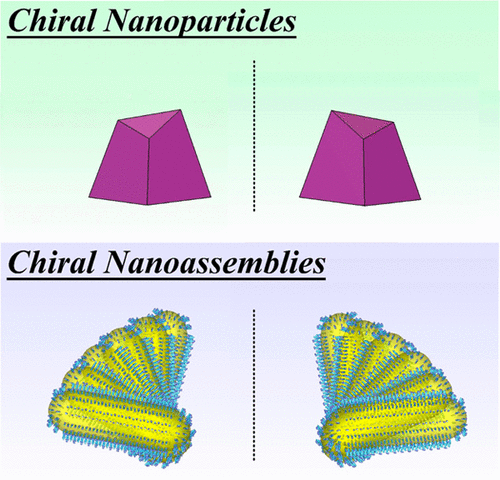当前位置:
X-MOL 学术
›
Chem. Rev.
›
论文详情
Our official English website, www.x-mol.net, welcomes your
feedback! (Note: you will need to create a separate account there.)
Chiral Inorganic Nanostructures
Chemical Reviews ( IF 51.4 ) Pub Date : 2017-04-20 00:00:00 , DOI: 10.1021/acs.chemrev.6b00755 Wei Ma , Liguang Xu , André F. de Moura 1 , Xiaoling Wu , Hua Kuang , Chuanlai Xu , Nicholas A. Kotov
Chemical Reviews ( IF 51.4 ) Pub Date : 2017-04-20 00:00:00 , DOI: 10.1021/acs.chemrev.6b00755 Wei Ma , Liguang Xu , André F. de Moura 1 , Xiaoling Wu , Hua Kuang , Chuanlai Xu , Nicholas A. Kotov
Affiliation

|
The field of chiral inorganic nanostructures is rapidly expanding. It started from the observation of strong circular dichroism during the synthesis of individual nanoparticles (NPs) and their assemblies and expanded to sophisticated synthetic protocols involving nanostructures from metals, semiconductors, ceramics, and nanocarbons. Besides the well-established chirality transfer from bioorganic molecules, other methods to impart handedness to nanoscale matter specific to inorganic materials were discovered, including three-dimentional lithography, multiphoton chirality transfer, polarization effects in nanoscale assemblies, and others. Multiple chiral geometries were observed with characteristic scales from ångströms to microns. Uniquely high values of chiral anisotropy factors that spurred the development of the field and differentiate it from chiral structures studied before, are now well understood; they originate from strong resonances of incident electromagnetic waves with plasmonic and excitonic states typical for metals and semiconductors. At the same time, distinct similarities with chiral supramolecular and biological systems also emerged. They can be seen in the synthesis and separation methods, chemical properties of individual NPs, geometries of the nanoparticle assemblies, and interactions with biological membranes. Their analysis can help us understand in greater depth the role of chiral asymmetry in nature inclusive of both earth and space. Consideration of both differences and similarities between chiral inorganic, organic, and biological nanostructures will also accelerate the development of technologies based on chiroplasmonic and chiroexcitonic effects. This review will cover both experiment and theory of chiral nanostructures starting with the origin and multiple components of mirror asymmetry of individual NPs and their assemblies. We shall consider four different types of chirality in nanostructures and related physical, chemical, and biological effects. Synthetic methods for chiral inorganic nanostructures are systematized according to chirality types, materials, and scales. We also assess technological prospects of chiral inorganic materials with current front runners being biosensing, chiral catalysis, and chiral photonics. Prospective venues for future fundamental research are discussed in the conclusion of this review.
中文翻译:

手性无机纳米结构
手性无机纳米结构的领域正在迅速扩大。它从观察单个纳米颗粒(NP)及其组装过程中的强圆二色性开始,扩展到涉及金属,半导体,陶瓷和纳米碳纳米结构的复杂合成方案。除了从生物有机分子中确立的手性转移,还发现了其他方法来赋予无机材料特有的纳米级物质以手性,包括三维光刻,多光子手性转移,纳米级组件中的极化效应等。观察到多种手性几何结构,其特征尺度从ångströms到微米。现在已经很好地理解了手性各向异性因子的独特高价值,它促使了该领域的发展并将其与之前研究的手性结构区分开来;它们源于入射电磁波在金属和半导体中典型具有等离子体和激子态的强共振。同时,也出现了与手性超分子和生物系统的明显相似之处。可以在合成和分离方法,单个NP的化学性质,纳米颗粒组件的几何形状以及与生物膜的相互作用中看到它们。他们的分析可以帮助我们更深入地了解手性不对称在包括地球和空间在内的自然界中的作用。考虑手性无机,有机,生物纳米结构也将加快基于手性等离子体和手性兴奋效应的技术的发展。这篇综述将涵盖手性纳米结构的实验和理论,从单个NP及其组装体的镜面不对称的起源和多个组成部分入手。我们将考虑纳米结构中的四种不同类型的手性以及相关的物理,化学和生物效应。根据手性类型,材料和规模,系统化了手性无机纳米结构的合成方法。我们还将评估手性无机材料的技术前景,其中目前的领先者是生物传感,手性催化和手性光子学。在这篇综述的结论中讨论了未来基础研究的潜在场所。
更新日期:2017-04-20
中文翻译:

手性无机纳米结构
手性无机纳米结构的领域正在迅速扩大。它从观察单个纳米颗粒(NP)及其组装过程中的强圆二色性开始,扩展到涉及金属,半导体,陶瓷和纳米碳纳米结构的复杂合成方案。除了从生物有机分子中确立的手性转移,还发现了其他方法来赋予无机材料特有的纳米级物质以手性,包括三维光刻,多光子手性转移,纳米级组件中的极化效应等。观察到多种手性几何结构,其特征尺度从ångströms到微米。现在已经很好地理解了手性各向异性因子的独特高价值,它促使了该领域的发展并将其与之前研究的手性结构区分开来;它们源于入射电磁波在金属和半导体中典型具有等离子体和激子态的强共振。同时,也出现了与手性超分子和生物系统的明显相似之处。可以在合成和分离方法,单个NP的化学性质,纳米颗粒组件的几何形状以及与生物膜的相互作用中看到它们。他们的分析可以帮助我们更深入地了解手性不对称在包括地球和空间在内的自然界中的作用。考虑手性无机,有机,生物纳米结构也将加快基于手性等离子体和手性兴奋效应的技术的发展。这篇综述将涵盖手性纳米结构的实验和理论,从单个NP及其组装体的镜面不对称的起源和多个组成部分入手。我们将考虑纳米结构中的四种不同类型的手性以及相关的物理,化学和生物效应。根据手性类型,材料和规模,系统化了手性无机纳米结构的合成方法。我们还将评估手性无机材料的技术前景,其中目前的领先者是生物传感,手性催化和手性光子学。在这篇综述的结论中讨论了未来基础研究的潜在场所。











































 京公网安备 11010802027423号
京公网安备 11010802027423号